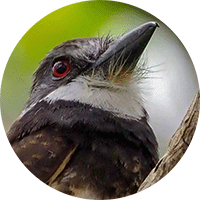Bobo de Noanamá
Sooty-capped Puffbird
Nystactes noanamae
Song
Sooty-capped Puffbird
Appearance: The Sooty-capped Puffbird is a medium-sized bird measuring around 18 cm in length. This bird features a sooty or dark-colored cap on its head. The rest of its body is a mix of brown and white, with a speckled or streaked appearance. It has a stout, slightly hooked beak common of puffbirds, which is adapted for catching insects.
Habitat: The Sooty-capped Puffbird is found in humid tropical and subtropical forests, including primary and secondary growth forests. It prefers dense forested areas, where it can perch quietly while scanning for prey.
Behavior: This puffbird feeds on insects and small invertebrates. It hunts by perching silently and then sallying out to capture prey. The Sooty-capped Puffbird is known for its calls, which are heard before the bird is seen. These calls are an important part of its territorial behavior. It tends to sit motionless on branches for extended periods, making it difficult to spot despite its size.
Breeding: Information on the breeding habits of the Sooty-capped Puffbird is limited. It is likely to nest in tree cavities or burrows in banks. Breeding pairs are monogamous, and both parents raise the young.
Conservation Status: The Sooty-capped Puffbird is classified as Near Threatened by the International Union for Conservation of Nature (IUCN).
Distribution
The Sooty-capped Puffbird is an endemic species found in the lowland forests of western Colombia in the Chocó region. This area is known for its high biodiversity and unique ecosystems. The species prefers humid forest environments, often near water bodies, and is found at elevations ranging from sea level to about 150 m.
As for its purpose or ecological role, like other puffbirds, the Sooty-capped Puffbird is an insectivore, feeding on a variety of insects and other small invertebrates. This feeding behavior helps control insect populations, contributing to the ecological balance within its habitat.
Puffbirds are known for their distinctive perching behavior, often sitting still for long periods before darting out to catch prey. This makes them important participants in the forest food web, both as predators and as potential prey for larger animals.
Taxonomy
The Name of Bird (Nystactes noanamae)
- Kingdom: Animalia
- Phylum: Chordata
- Class: Aves (Birds)
- Order: Galbuliformes
- Family: Bucconidae
- Genus: Nystactes
- Species: Nystactes noanamae
Vocalization
The vocalizations of the Sooty-capped Puffbird are not as extensively documented as those of more common or widespread species, but like other puffbirds, they are known to produce a series of calls that are used for communication. These calls can include whistles, trills, or repetitive notes. The specific sounds may vary based on their purpose, such as attracting a mate, defending territory, or signaling alarm.





